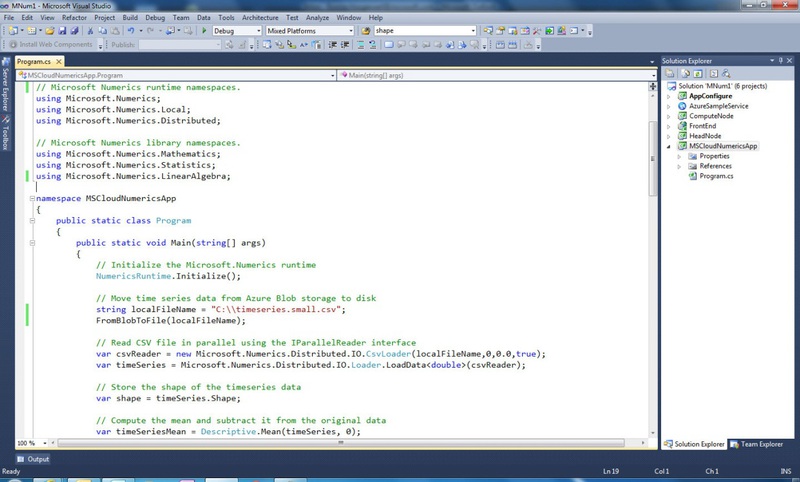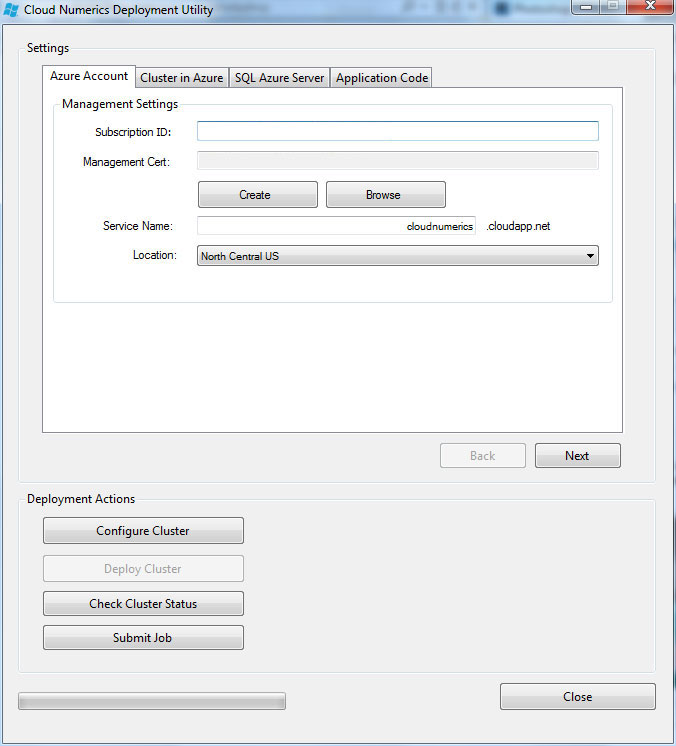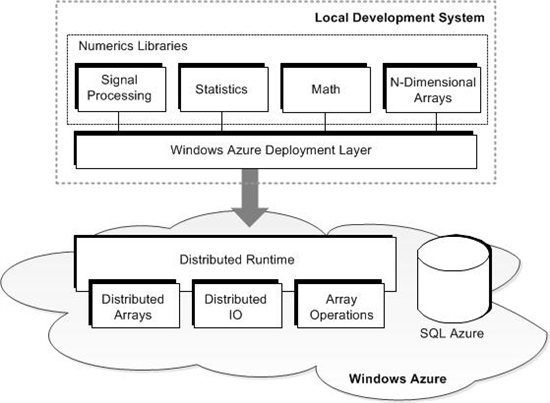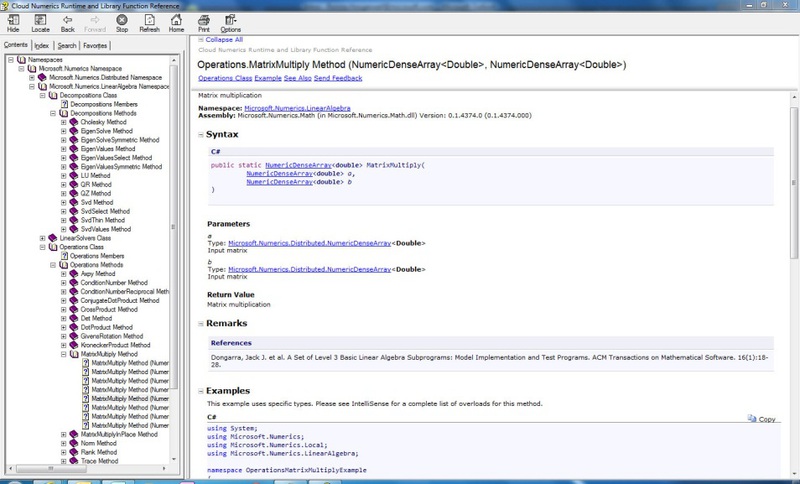Microsoft released a cloud-optimized math library: Cloud Numerics
This week, Microsoft announced the release of a new product for Azure and the .Net platform - Microsoft Codename “Cloud Numerics” Lab. This is a mathematical library capable of parallel processing of large amounts of data in the cloud. It also allows you to scale the computational models implemented in C # for Windows Azure.
The release of this library was the fruit of several years of serious work of specialists in the field of parallel computing and computational mathematics. Much of this work was done by the Russian division of Microsoft.
This library provides a user-friendly programming model that hides the complexity of developing distributed algorithms, access to the .NET library of numerical algorithms consisting of a wide range of functions. From elementary to complex statistical and linear algebra functions. Cloud Numerics also provides the ability to run programs in Azure and access unlimited computing power in the cloud.
')
As a rule, writing numerical algorithms, especially those capable of working on parallel computing architectures, is not an easy task. This requires a deep understanding of the underlying computational architecture and mathematics. This kind of work lies in the field of competence of experts with many years of experience. Creating the same numerical algorithms that can scale to the cloud is an order of magnitude more difficult.
It is known that the ever-growing appetite for data and their processing makes the need for scaling up the computation process and analyzing it more or less when needed. And it is in this area “Cloud Numerics” helps to achieve maximum results, with minimal effort. For example, using “Cloud Numerics”, it becomes possible to write an application for classifying documents or analyzing time series without too much difficulty.
The library is an evolving solution for writing distributed applications that can be run simultaneously on multiple Windows Azure nodes. To use it, you just need to run Visual Studio with a specially prepared project template that includes a library with a wide range of functions.
Cloud Numerics has more than 400 functions covering the problems of statistics, linear algebra, Fourier transforms collected in the following namespaces:

You can use the “Cloud Numerics” project for Visual Studio, which gives you constant access to distributed data arrays and library functions:

The development and debugging of the application is carried out at your workplace with test data suitable for your workstation. Your application can read data in parallel, distribute and manipulate big data as distributed arrays and run math functions for parallel processing.
When your application is ready and you want to scale it by running in the cloud, you just need to launch the Deployment Wizard, fill out your Azure account information and run the application in the cloud:

Running on Windows Azure is as follows:

A ready-made, locally assembled project is sent to the cloud through the Deployment Wizard, gaining access to the number of nodes specified by the Wizard on the deployable HPC cluster. At the time of execution, the control receives an instance with a zero rank and starts executing a calculation program. Further, special “distributed functions” can be run and the rest of the nodes get control. They perform operations on, or pre-distributed data array, or carries out this distribution independently in the control flow of the main module.
“Cloud Numerics” also has detailed documentation:

Download the distribution you can link: connect.microsoft.com
When prompted, enter your invitation code for the “Cloud Numerics” lab which you can get here.
You can learn more about the “Cloud Numerics” on the Microsoft Codename “Cloud Numerics” Lab site or on the Getting Started material site. You can write reviews to cnumerics-feedback@microsoft.com.
The release of this library was the fruit of several years of serious work of specialists in the field of parallel computing and computational mathematics. Much of this work was done by the Russian division of Microsoft.
This library provides a user-friendly programming model that hides the complexity of developing distributed algorithms, access to the .NET library of numerical algorithms consisting of a wide range of functions. From elementary to complex statistical and linear algebra functions. Cloud Numerics also provides the ability to run programs in Azure and access unlimited computing power in the cloud.
')
As a rule, writing numerical algorithms, especially those capable of working on parallel computing architectures, is not an easy task. This requires a deep understanding of the underlying computational architecture and mathematics. This kind of work lies in the field of competence of experts with many years of experience. Creating the same numerical algorithms that can scale to the cloud is an order of magnitude more difficult.
It is known that the ever-growing appetite for data and their processing makes the need for scaling up the computation process and analyzing it more or less when needed. And it is in this area “Cloud Numerics” helps to achieve maximum results, with minimal effort. For example, using “Cloud Numerics”, it becomes possible to write an application for classifying documents or analyzing time series without too much difficulty.
The library is an evolving solution for writing distributed applications that can be run simultaneously on multiple Windows Azure nodes. To use it, you just need to run Visual Studio with a specially prepared project template that includes a library with a wide range of functions.
Cloud Numerics has more than 400 functions covering the problems of statistics, linear algebra, Fourier transforms collected in the following namespaces:

You can use the “Cloud Numerics” project for Visual Studio, which gives you constant access to distributed data arrays and library functions:

The development and debugging of the application is carried out at your workplace with test data suitable for your workstation. Your application can read data in parallel, distribute and manipulate big data as distributed arrays and run math functions for parallel processing.
When your application is ready and you want to scale it by running in the cloud, you just need to launch the Deployment Wizard, fill out your Azure account information and run the application in the cloud:

Running on Windows Azure is as follows:

A ready-made, locally assembled project is sent to the cloud through the Deployment Wizard, gaining access to the number of nodes specified by the Wizard on the deployable HPC cluster. At the time of execution, the control receives an instance with a zero rank and starts executing a calculation program. Further, special “distributed functions” can be run and the rest of the nodes get control. They perform operations on, or pre-distributed data array, or carries out this distribution independently in the control flow of the main module.
“Cloud Numerics” also has detailed documentation:

Download the distribution you can link: connect.microsoft.com
When prompted, enter your invitation code for the “Cloud Numerics” lab which you can get here.
You can learn more about the “Cloud Numerics” on the Microsoft Codename “Cloud Numerics” Lab site or on the Getting Started material site. You can write reviews to cnumerics-feedback@microsoft.com.
Source: https://habr.com/ru/post/136662/
All Articles